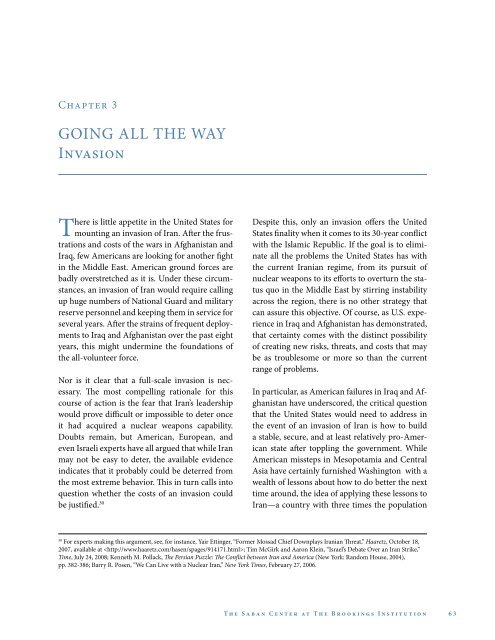WHICH PATH TO PERSIA?
You also want an ePaper? Increase the reach of your titles
YUMPU automatically turns print PDFs into web optimized ePapers that Google loves.
Chapter 3<br />
GOING ALL THE WAY<br />
Invasion<br />
There is little appetite in the United States for<br />
mounting an invasion of Iran. After the frustrations<br />
and costs of the wars in Afghanistan and<br />
Iraq, few Americans are looking for another fight<br />
in the Middle East. American ground forces are<br />
badly overstretched as it is. Under these circumstances,<br />
an invasion of Iran would require calling<br />
up huge numbers of National Guard and military<br />
reserve personnel and keeping them in service for<br />
several years. After the strains of frequent deployments<br />
to Iraq and Afghanistan over the past eight<br />
years, this might undermine the foundations of<br />
the all-volunteer force.<br />
Nor is it clear that a full-scale invasion is necessary.<br />
The most compelling rationale for this<br />
course of action is the fear that Iran’s leadership<br />
would prove difficult or impossible to deter once<br />
it had acquired a nuclear weapons capability.<br />
Doubts remain, but American, European, and<br />
even Israeli experts have all argued that while Iran<br />
may not be easy to deter, the available evidence<br />
indicates that it probably could be deterred from<br />
the most extreme behavior. This in turn calls into<br />
question whether the costs of an invasion could<br />
be justified. 30<br />
Despite this, only an invasion offers the United<br />
States finality when it comes to its 30-year conflict<br />
with the Islamic Republic. If the goal is to eliminate<br />
all the problems the United States has with<br />
the current Iranian regime, from its pursuit of<br />
nuclear weapons to its efforts to overturn the status<br />
quo in the Middle East by stirring instability<br />
across the region, there is no other strategy that<br />
can assure this objective. Of course, as U.S. experience<br />
in Iraq and Afghanistan has demonstrated,<br />
that certainty comes with the distinct possibility<br />
of creating new risks, threats, and costs that may<br />
be as troublesome or more so than the current<br />
range of problems.<br />
In particular, as American failures in Iraq and Afghanistan<br />
have underscored, the critical question<br />
that the United States would need to address in<br />
the event of an invasion of Iran is how to build<br />
a stable, secure, and at least relatively pro-American<br />
state after toppling the government. While<br />
American missteps in Mesopotamia and Central<br />
Asia have certainly furnished Washington with a<br />
wealth of lessons about how to do better the next<br />
time around, the idea of applying these lessons to<br />
Iran—a country with three times the population<br />
30<br />
For experts making this argument, see, for instance, Yair Ettinger, “Former Mossad Chief Downplays Iranian Threat,” Haaretz, October 18,<br />
2007, available at ; Tim McGirk and Aaron Klein, “Israel’s Debate Over an Iran Strike,”<br />
Time, July 24, 2008; Kenneth M. Pollack, The Persian Puzzle: The Conflict between Iran and America (New York: Random House, 2004),<br />
pp. 382-386; Barry R. Posen, “We Can Live with a Nuclear Iran,” New York Times, February 27, 2006.<br />
T h e S a b a n C e n t e r a t T h e B r o o k i n g s I n s t i t u t i o n 6 3

















